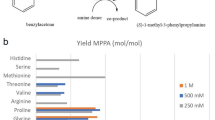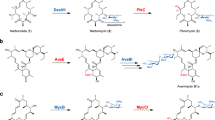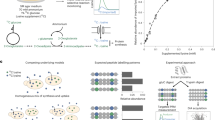Abstract
YEAST 47 1 grows well in a defined salts–glucose–ammonia medium, containing p-aminobenzoic acid, biotin, pantothenic acid and inositol2. This medium, supplemented with 500 µgm. of L- (or 1,000 µgm. of DL-) methionine per ml., but containing suboptimal concentrations (0.003–0.04 mµgm./ml.) of D-biotin, yields yeast crops after 72–96 hr. at 28° which are unusual in that they are pink in colour. Other conditions being suitable, the colour is not formed (1) if any other amino-acid is substituted for methionine; (2) if the concentration of D-biotin is raised to 0.08 mµgm./ml.; (3) in the presence of optimal biotin, but suboptimal pantothenate, p-aminobenzoic acid or inositol. Formation of the pink pigment is thus associated with the presence of methionine and with a relative deficiency of biotin.
This is a preview of subscription content, access via your institution
Access options
Subscribe to this journal
Receive 51 print issues and online access
$199.00 per year
only $3.90 per issue
Buy this article
- Purchase on SpringerLink
- Instant access to full article PDF
Prices may be subject to local taxes which are calculated during checkout
Similar content being viewed by others
References
Rainbow, C., Nature, 162, 572 (1948).
Cutts, N. S., and Rainbow, C., J. Gen. Microbiol., 4 (1950).
Northam, B. E., and Norris, F. W., J. Gen. Microbiol. (in the press).
Lindegren, C. C., and Lindegren, G., Proc. U.S. Nat. Acad. Sci., 33, 314 (1947).
Author information
Authors and Affiliations
Rights and permissions
About this article
Cite this article
CUTTS, N., RAINBOW, C. Methionine and the Formation of Pigment by Yeasts. Nature 166, 1117 (1950). https://doi.org/10.1038/1661117b0
Issue date:
DOI: https://doi.org/10.1038/1661117b0



